The ASUS Maximus VIII Impact Z170 ROG Mini-ITX Motherboard Review
by Ian Cutress on December 29, 2015 9:00 AM ESTASUS Maximus VIII Impact Z170 ROG BIOS
For users well accustomed to BIOS layout, it makes sense when a company uses the same basic libraries throughout their product stack. It makes sense for time and development, and there can be some leeway in customization for different types of products. So this is what I mean when I say that users who are familiar with ASUS’ main line of motherboards (the -Pro, the -A, the -Deluxe and other) will also understand what goes on with ROG. There are differences, and the first two to notice are the color scheme moving red but also that the BIOS enters straight into advanced mode, bypassing EZ mode.
But let us step back a bit, and move to EZ mode. For users who want to deal only in EZ mode, there is a setting which forces it as the default BIOS entry point.
Similar to other EZ modes we have seen from ASUS, this one gives details on the motherboard name, the BIOS version, the CPU installed, the speed of the CPU, the amount of memory installed, a graph of CPU temperature over time (useful if you’ve ever forgot to plug in the CPU fan… oops), the CPU voltage, the motherboard chipset temperature the speed the memory is running at, a per-DRAM slot label of what memory is installed, a per-SATA port label of what drives are installed, a quick button for XMP, a quick button for RST, a per-fan rundown of fan speeds, a diagram of the fan power control for the CPU fan, a quick button to customize the fan profiles, an EZ system tuning list for quick updating, and a boot priority list. Pretty much 90% of what you want a motherboard for, especially if you are the family computer guy fixing it and it is hidden in a pile of dust.
Pressing F11 brings up the EZ Tuning Wizard to help users get some basic overclocking and RAID controls.
The EZ Wizard asks a couple of questions, such as what the system is used for (gaming or daily tasks/media consumption), what cooling is installed (stock cooler, tower cooler, liquid cooling, unknown), and then uses a lookup table and attempts to apply a sufficient overclock. It beats many ‘set it and see’ overclocking tools on other motherboards purely on user experience, even if results are similar.
Here for example I chose Daily Computing with a Stock Cooler, and it offered a 10% overclock for the i7-6700K (moving from 4.0 GHz to 4.4 GHz) and no chance in the DRAM (DDR4-2133), then asked to enable it.
For the EZ RAID option, this makes the task of implementing RST on Intel configured RAID ports easier by providing a step-by-step guide.
Also on the EZ Mode page we have access to quick fan controls under Q-Fan:
The system will allow each fan to be configured either by PWM or DC controls where possible, and offers four presets (standard, silent, turbo, full speed) as well as manual control of a multi-point fan gradient. On the left hand side is the ‘Optimize All’ option, which provides per-fan tuning.
Moving back into Advanced Mode, and similar to previous motherboards ASUS is offering a My Favorites menu to allow users who have specific settings they want to tweak (typically overclockers), then options can be added here. For the Z170 platform, ASUS is now pre-filling the My Favorites menu with a number of options they feel are best suited for overclocking, such as core ratios, base frequency, DRAM multiplier, voltages and power options.
For the main glut of overclocking options though, the Extreme Tweaker menu has them all.
A wider range of CPU overclocking options are exposed on this first set of screens, with additional menu options for DRAM, power management and ‘extreme tweaking’. For users with the LN2 header enabled, more obscure options are also offered. However, the first option at the top is relatively interesting as a set of overclocking presets:
The majority of these are for extreme overclockers, but the Gamers’ OC profile is one we have tested in the OC section (along with the TPU options). The Gamers’ OC gives a 48/47/46/45 multiplier overclock with 1.425 volts set in the BIOS with LLC at Level 7. On our test bed with our #3 CPU, this passed our tests.
Similarly in the DRAM section, we also get a list of presets for extreme overclocking:
Most of these require knowledge into the memory you have, and are typically used by those close to ASUS’ in-house overclocking team.
Moving away from overclocking, and the Advanced menu holds most of the typical motherboard options for enabling/disabling controllers, organizing storage controls, C-states and USB configuration. I think the best bit about this is the SMART information screen.
Similar to OS tools to read SMART data, here we get information about power-on hours, power cycles and drive temperature. This sort of information tool is slowly moving into BIOSes of all the manufacturers, which is a good thing to see.
Next up in the BIOS is the monitoring tools, which also doubles as the place for manual fan controls without the graph.
As the Impact has several additional temperature sensor headers onboard for additional thermistors, these can be added and configured here as well.
The Q-Fan control in text looks similar to other fan control software, and allows for separate fan header adjustment in DC or PWM mode.
Boot override and CSM controls are found in the Boot Menu, which also has the option for Above 4G Decoding if anyone wants to pair the motherboard with a MIC.
The last set of features for the BIOS are in the Tool menu.
ASUS has updated its EZ Flash tool to generation 3, allowing it to also probe an online server for an updated BIOS version, which is similar to what ASRock does. Secure Erase still features in the ROG BIOSes, as well as overclocking profiles, SPD information and GPU information. The thing missing from ASUS’ repertoire is a Board Explorer mode, similar to what ASRock and MSI have, which shows a diagram of the motherboard and what is installed in each port. As a method of showing if certain DRAM modules are not detected, or SATA drives not found, it provides a good user experience for most users (though one could argue that the various lists around the BIOS already do this, though they are not currently in one place).


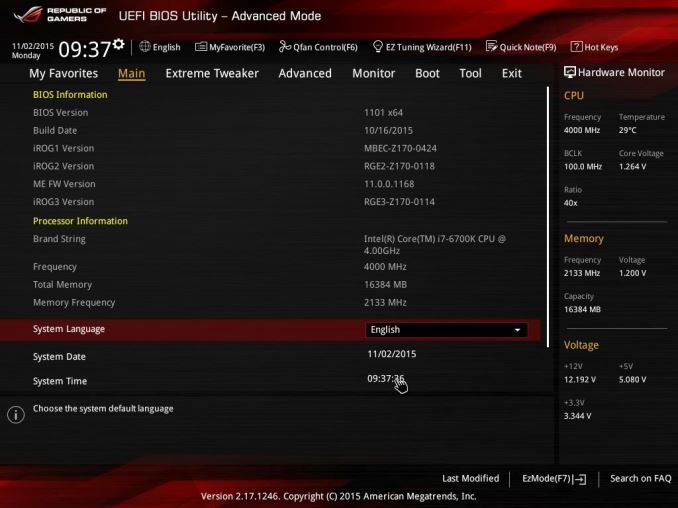
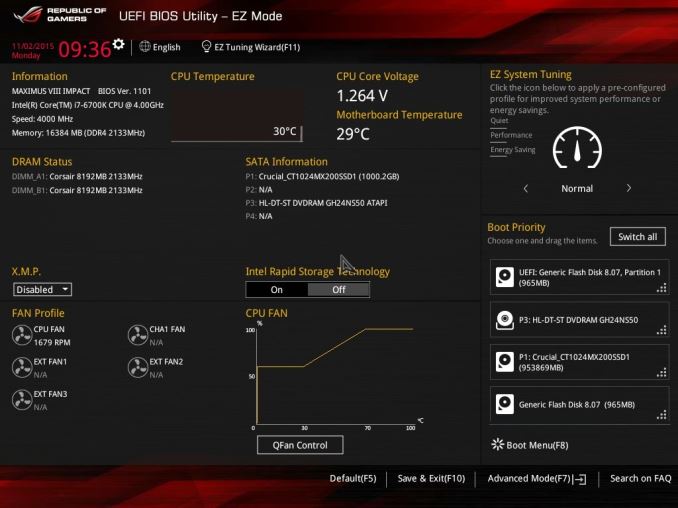
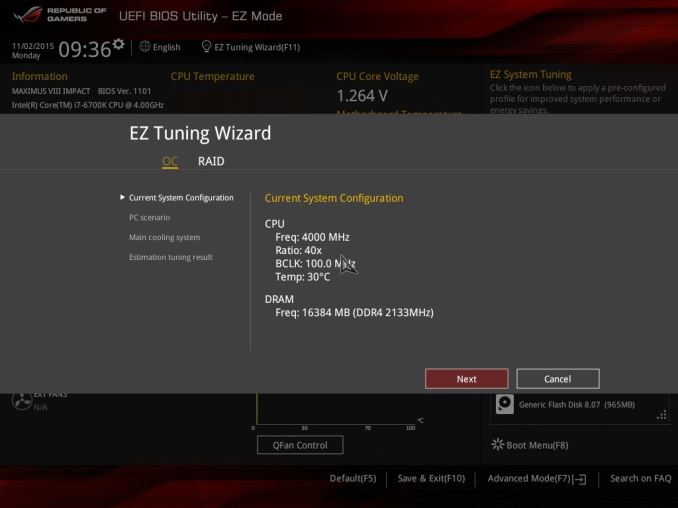
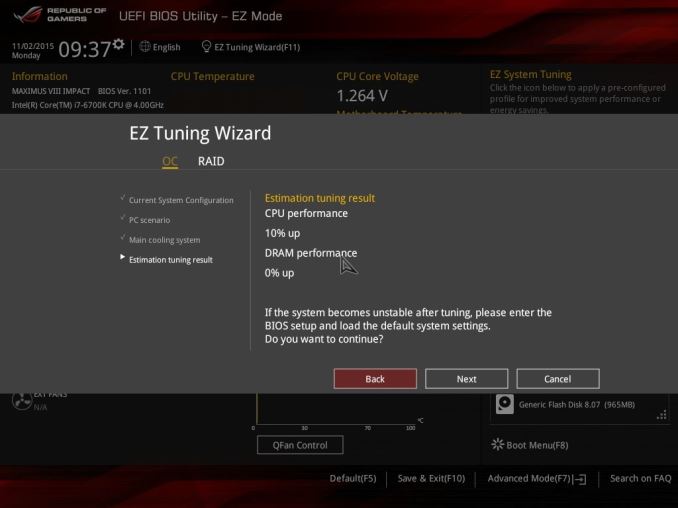

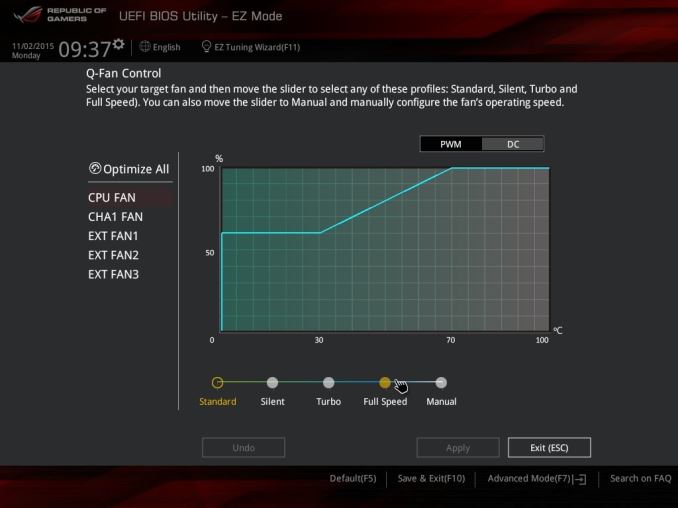
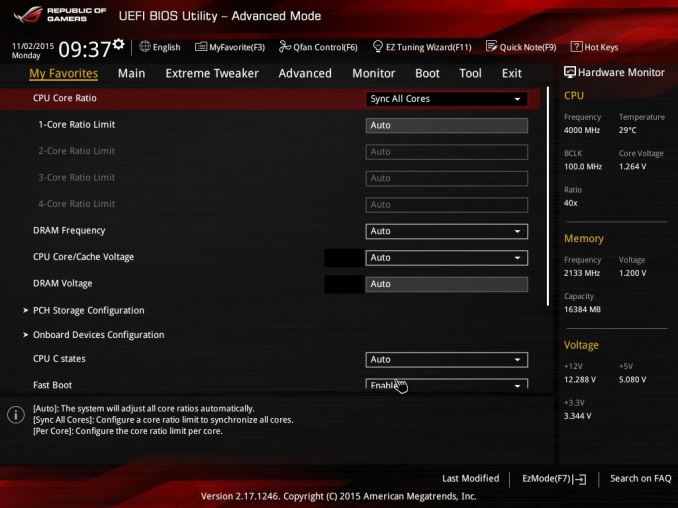
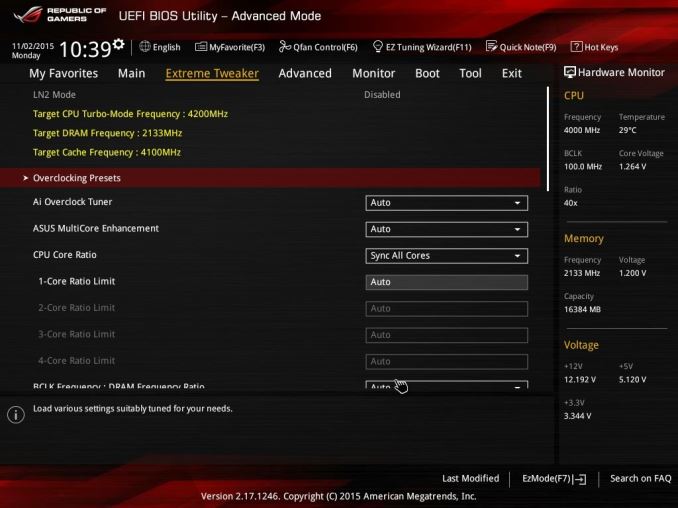
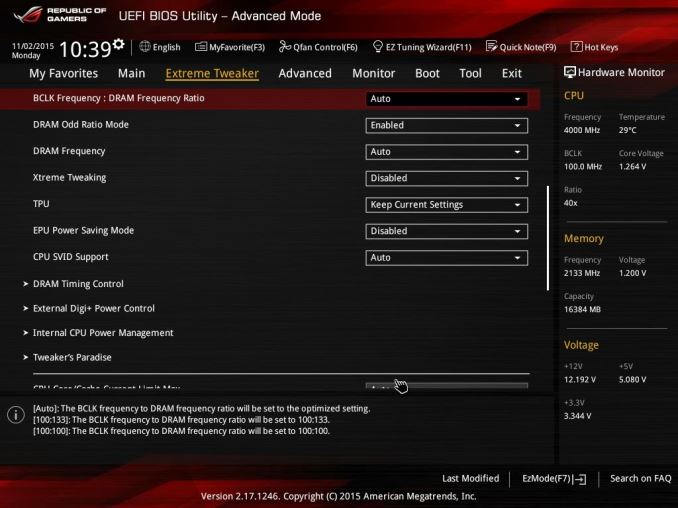
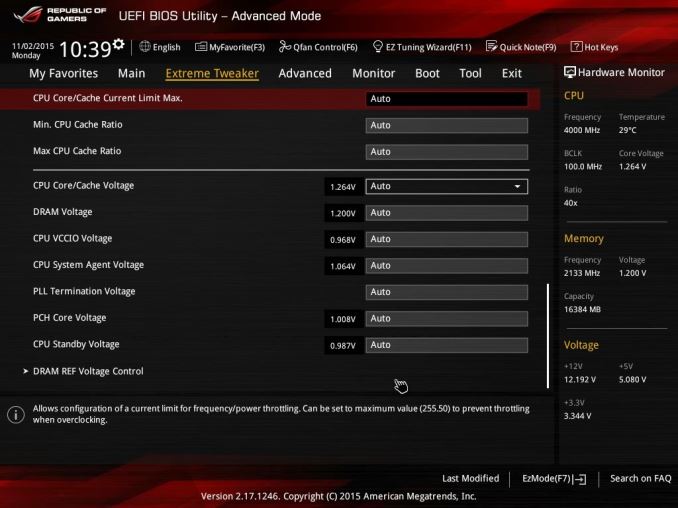
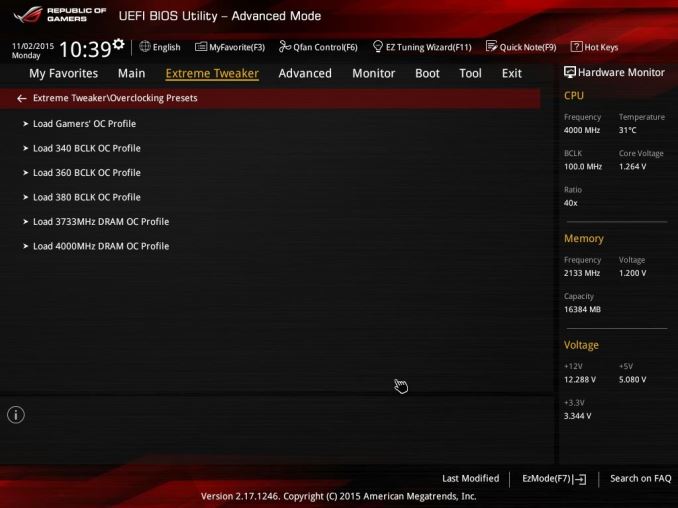
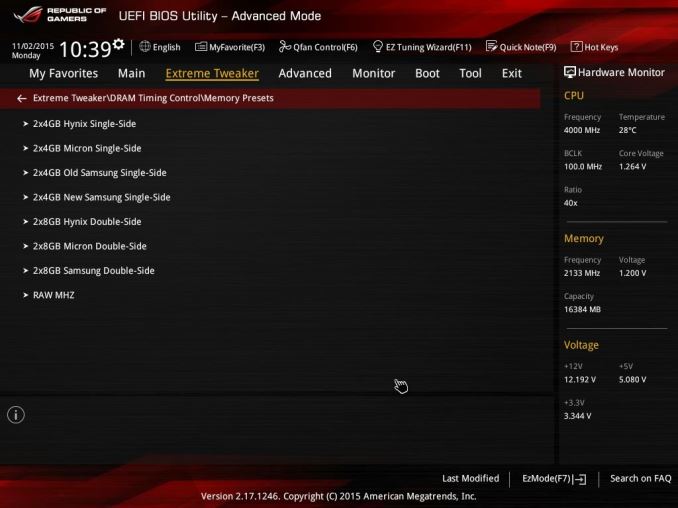
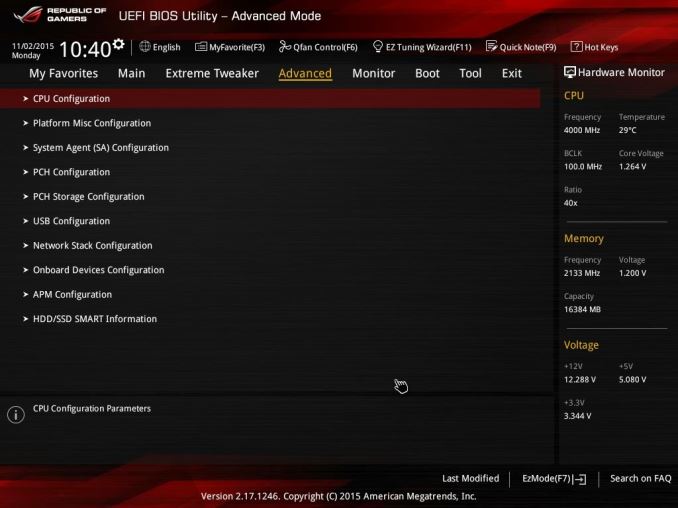
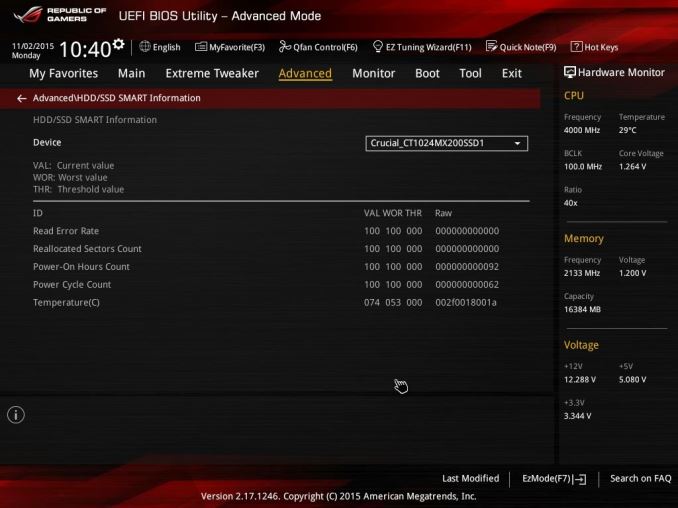
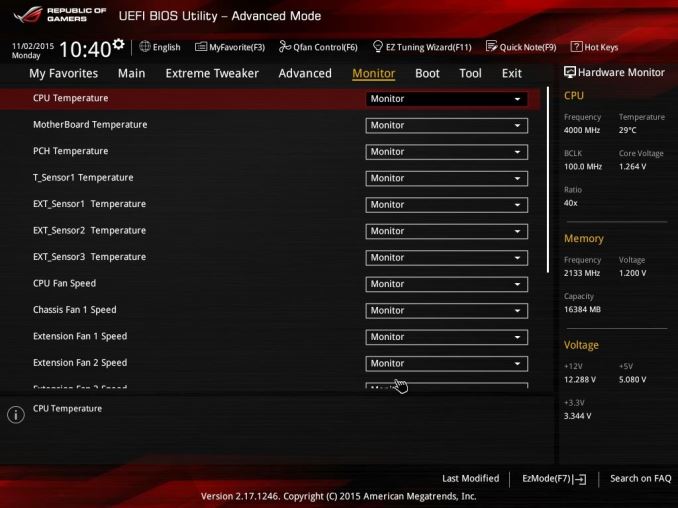
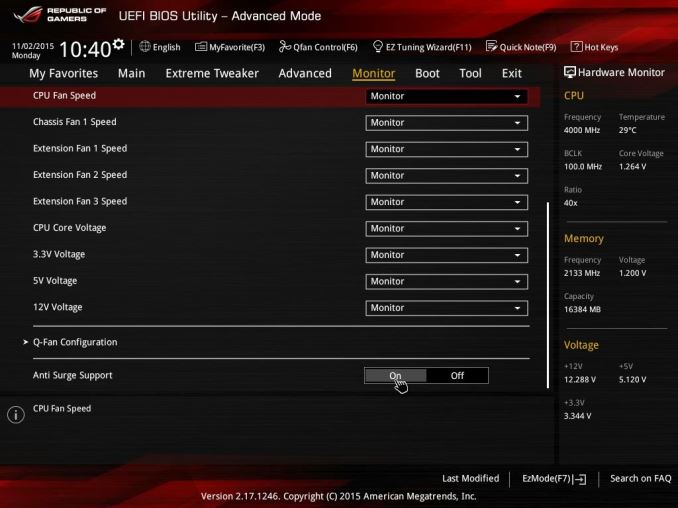
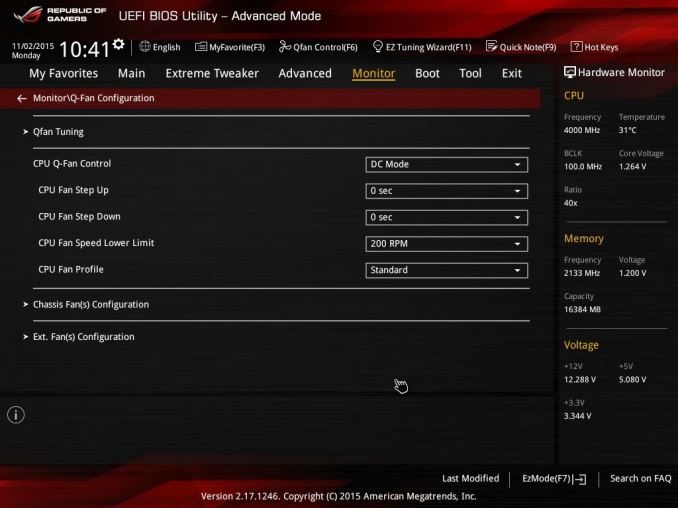
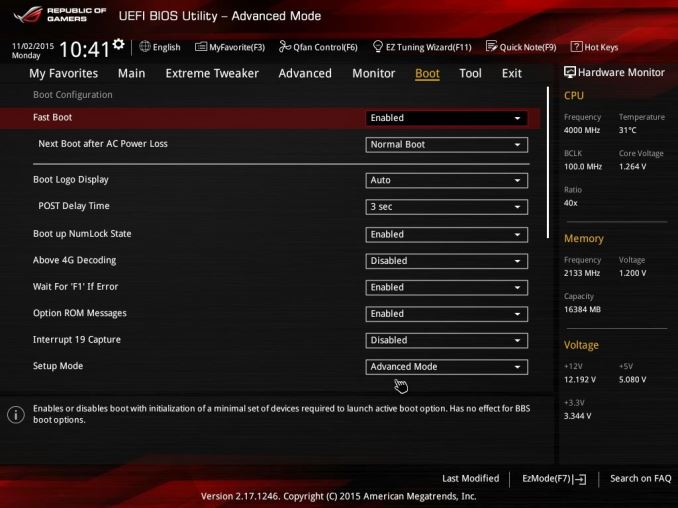
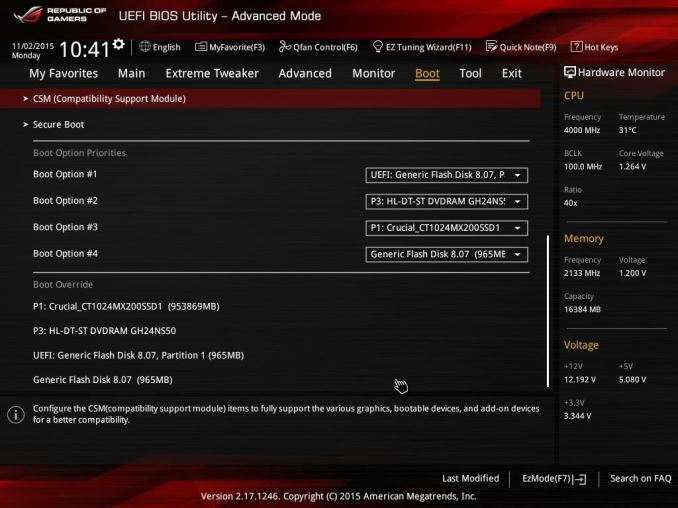
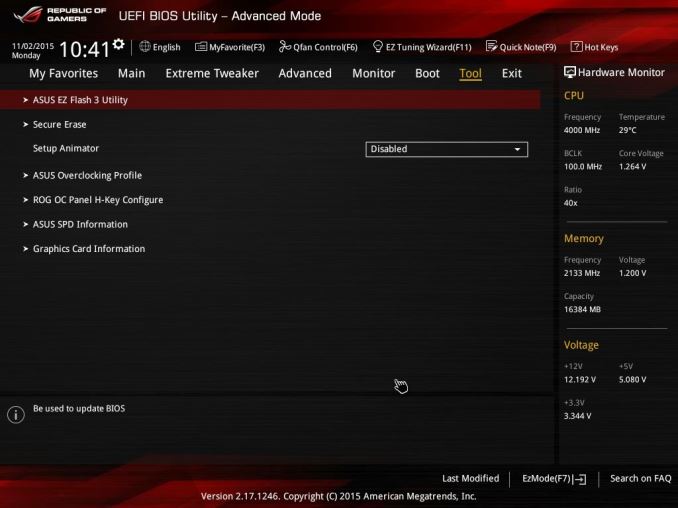














42 Comments
View All Comments
FelixDraconis - Wednesday, December 30, 2015 - link
Agreed with Mr. Elmore, but let me clarify. I'm a game programmer, myself. No, I do not have a college degree. I started too early for that. Writing clean documentation for others is one of the most important things I strive for. Picking good metaphors is also of vital importance. All things very similar to writing tech articles.Sure, some of my comments may be pedantic, but I'd rather have feedback than silence from my audience. I just hope that Mr. Ian will ponder them and decide to improve. We stop living when we stop learning. Anyway, I really just wanted to help. Anandtech is one of the best websites out there for tech articles and probably a great career builder.
Personally speaking, I stopped reading the text because it was hard to decipher. So, I suspect others would, too. Kind of defeats the purpose of writing it. Good luck, Mr. Ian!
mapesdhs - Wednesday, December 30, 2015 - link
Felix, personally I find your comments most welcome, better writing should be encouraged. Brevity is in short supply these days.SpartyOn - Tuesday, December 29, 2015 - link
I'm waiting for Nvidia Pascal to drop before updating my mini ITX Asus P8Z77-i Deluxe Ivy Bridge system. This review will heavily influence my opinion when it comes time to purchase. Looks pretty good to me.TheSlamma - Tuesday, December 29, 2015 - link
Ugh, Killer network cards SUCK Intel all the way homejasonelmore - Tuesday, December 29, 2015 - link
Asus never use Killer network cards, that's a MSI thing.. All Asus ROG boards use Intelmapesdhs - Wednesday, December 30, 2015 - link
I bought an MSI gaming laptop which has Killer E2400/wifi, works very well IMO. Far better wifi range than I've ever had before with a laptop, good GigE speeds too.mapesdhs - Wednesday, December 30, 2015 - link
Back in the Z97 era, I was pondering a Maximus VII IMPACT, but in the end I bought the ASUS Z97I-Plus instead, and very happy I am with it too. Many of the same features, cheaper, etc.Reading this article, I wondered if there was a S1151 equivalent; well, almost, namely the H170I-PLUS D3. Ian, Iike these top-end miniITX reviews, but it'd be nice to compare to something a bit further down the range. Afterall, the M8I doesn't have M.2, whereas the Z97I-Plus, and the newer H170I-Plus D3 both do have it, so the latter is surely worth of consideration.
mapesdhs - Wednesday, December 30, 2015 - link
(rats, still no edit function! Can we please make that a priority for AT in 2016? I meant to say, I like these top-end miniITX reviews, etc.)legolasyiu - Tuesday, January 5, 2016 - link
Ian, I bet your POST time will be better if you upgrade BIOS to 1302,Maximus VIII Impact BIOS 1302
1. Improve system stability
Visual - Wednesday, January 6, 2016 - link
Fun times, when "low end" gets to run 30fps on ultra, be it on a "low" resolution (that's still classified as HD, mind you).And the cherry on top is that even IGPs can finally do that, now if only they actually were put into some products... I wonder, why Intel seems to be purposely hiding the good Iris chips?